EMI TA Mid-Semester Training: Deep Learning from Cultural Differences to Communication Strategies
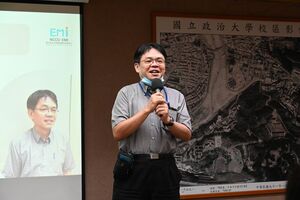
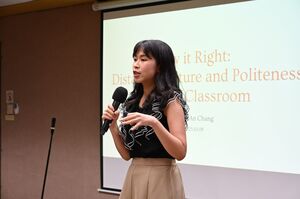
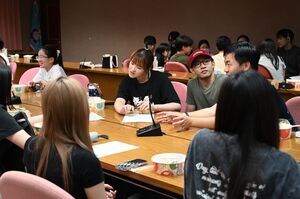
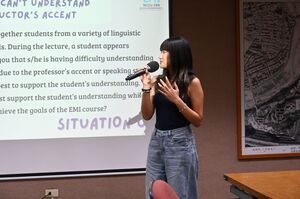
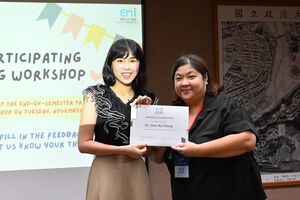
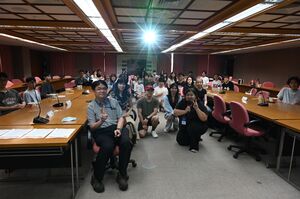
The event began with opening remarks by Professor Jyh-Jian Sheu, Associate Vice President for Academic Affairs, Director of the Center for Teaching and Learning Development, Associate Executive Convenor of the Bilingual Education and Multicultural Promotion Office, and Director of the EMI Resource Center. Professor Sheu expressed appreciation for the participants’ active engagement and continued commitment, acknowledging their vital role in bridging communication between instructors and students in EMI classrooms. He emphasized that such training sessions play a crucial role in promoting bilingual education and improving teaching quality across the university. The session was hosted by part-time assistant Abbie Lee.
The keynote lecture, titled “Say it Right: Distance, Culture, and Politeness in EMI Classrooms,” was delivered by Assistant Professor Chen-An Chang from the Department of English. Focusing on distance, cultural differences, and politeness strategies, the lecture explored intercultural communication dynamics in EMI classrooms and guided TAs in developing sensitivity and effective communication strategies across linguistic and cultural boundaries.
Professor Chang first highlighted the importance of communication in a TA’s role: as bridges between instructors and students, EMI TAs engage in both upward communication (with instructors) and downward communication (with students). Because EMI classrooms often consist of students from diverse cultural backgrounds, differences in communication styles and language comprehension can easily lead to misunderstandings. Therefore, TAs need to demonstrate intercultural sensitivity, communicating clearly, politely, and inclusively to maintain a positive and effective learning environment.
The lecture further discussed cultural differences in power distance. In high power-distance cultures, students tend to show strong respect for authority and seldom question instructors, whereas in low power-distance cultures, students are encouraged to ask questions and engage in open discussion. Consequently, EMI TAs should clearly define their roles—respecting the instructor’s teaching style while helping students better understand course content. When interacting with students, TAs can adopt a supportive and encouraging stance, helping them find a balance between respect and open expression.
Professor Chang also reminded participants of the distinction between high-context and low-context communication. High-context cultures (such as many East Asian ones) value indirectness and nonverbal cues, whereas low-context cultures (such as the U.S.) favor direct communication. By recognizing students’ communication tendencies, TAs can adjust their tone, vocabulary, and phrasing for clearer delivery. For instance, when working with East Asian students, TAs might use suggestions and softer tones to foster discussion, while in Western-dominant classrooms, they could use more explicit, directive language to improve efficiency. Through interactive situational practices, participants learned to apply appropriate tone and language across contexts, building the ability to communicate in ways that are effective, respectful, and culturally aware.
After the lecture, the workshop moved on to an interactive group activity, “Challenges in EMI Classes,” designed by part-time assistant Rachel Lin. Participants were divided into groups to discuss four common scenarios: Cultural differences in communication styles Translanguaging with accountability The student can’t understand the instructor’s accent Cultural differences in classroom expectations Each group actively discussed and then presented their solutions through short role-plays. Their creative and practical suggestions reflected the theoretical principles discussed earlier in the session. The ETRC team further elaborated on the related concepts and provided specific language strategies to help TAs transform theory into classroom-ready communication tools.
For example, in the translanguaging scenario, participants suggested that when students prefer using their first language during group discussions, TAs could encourage them to first express key terms or ideas in English, gradually building their speaking confidence without demanding perfect sentences. The ETRC staff expanded on this by connecting the practice to translanguaging theory, emphasizing that using one’s first language can aid conceptual understanding and peer support. Therefore, TAs should acknowledge its value while gently reminding students that English is the primary medium of communication in EMI courses—for instance, by saying, “I understand it’s easier to explain in your first language, but let’s try to keep the discussion in English so everyone can follow.”
The workshop concluded with a lively Slido voting and prize draw, where participants voted for the three most outstanding group performances. Overall, the EMI TA Mid-Semester Training Workshop was both insightful and practical, combining theoretical depth with hands-on learning. Through lectures and interactive activities, participants gained a stronger grasp of intercultural communication concepts and concrete classroom strategies, laying a solid foundation for their continued work as effective and culturally responsive EMI teaching assistants.
